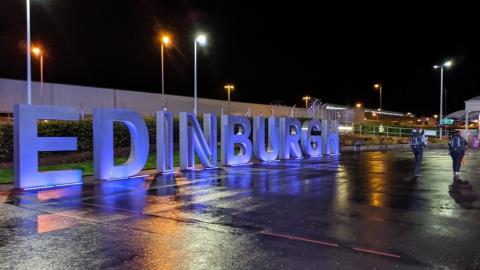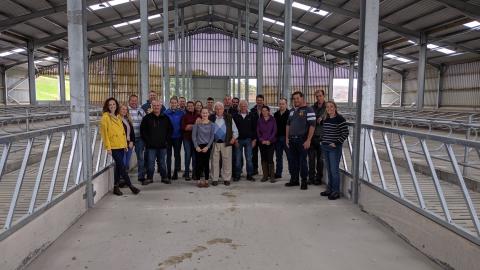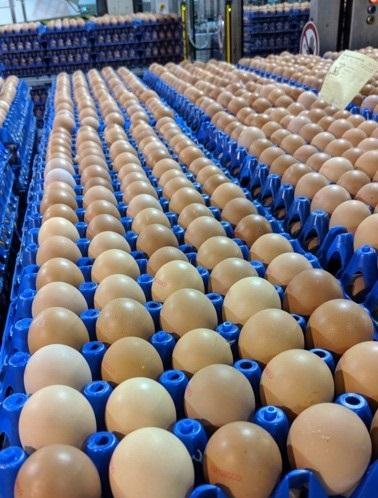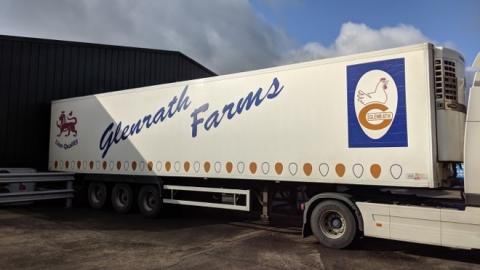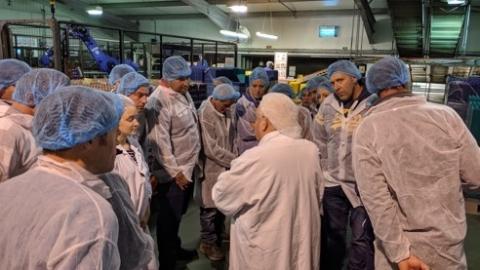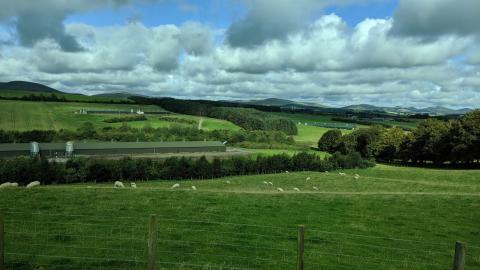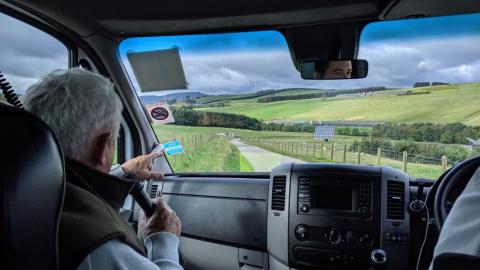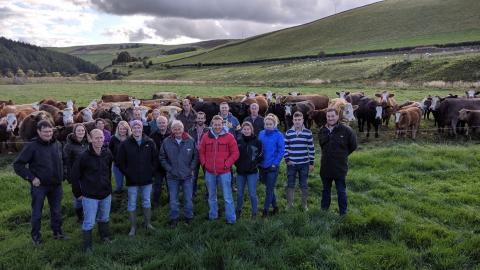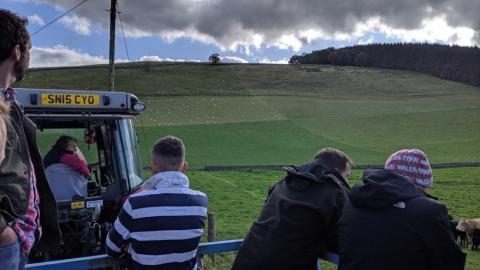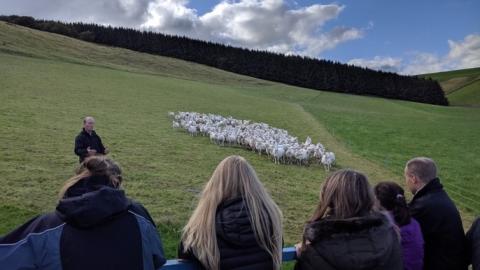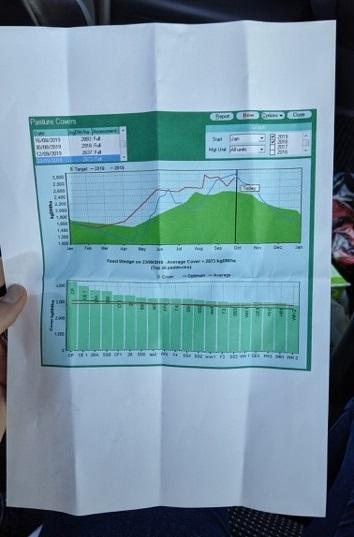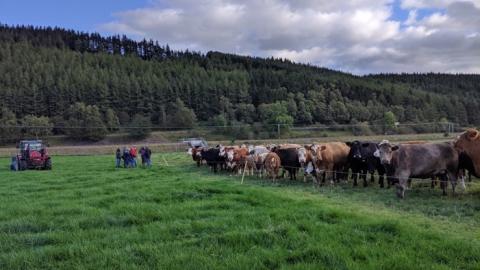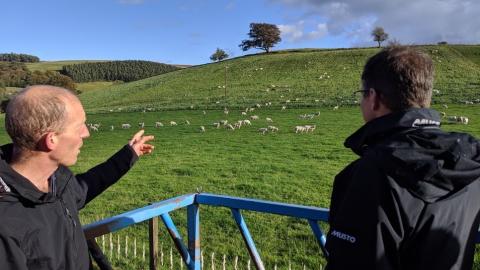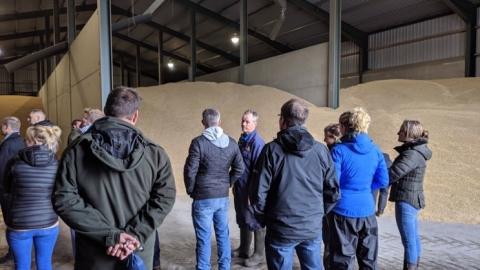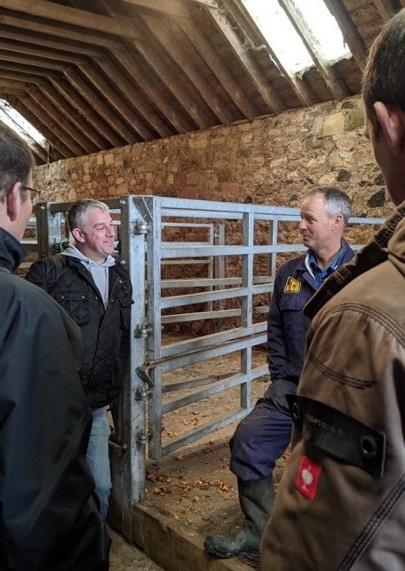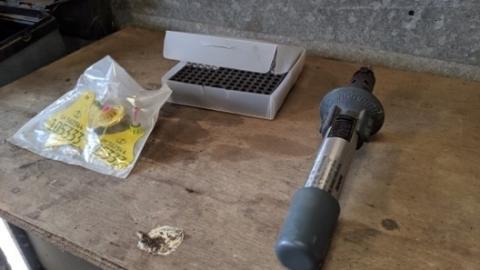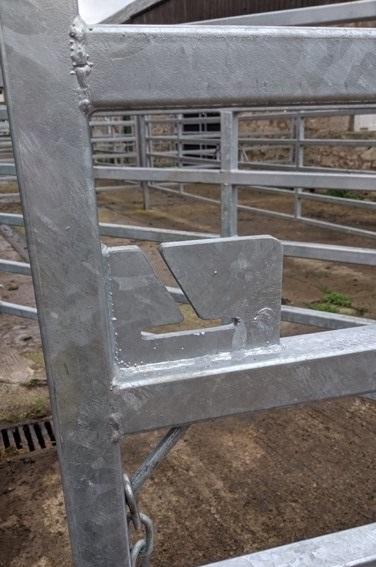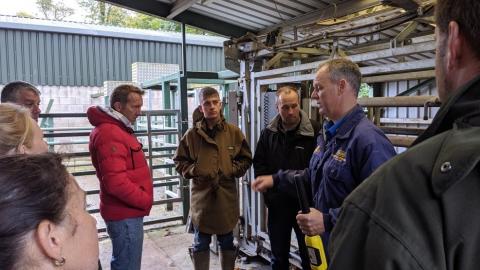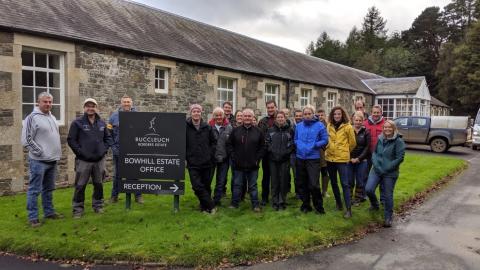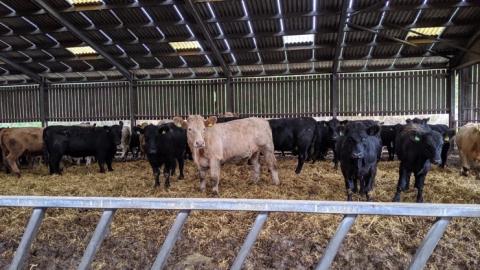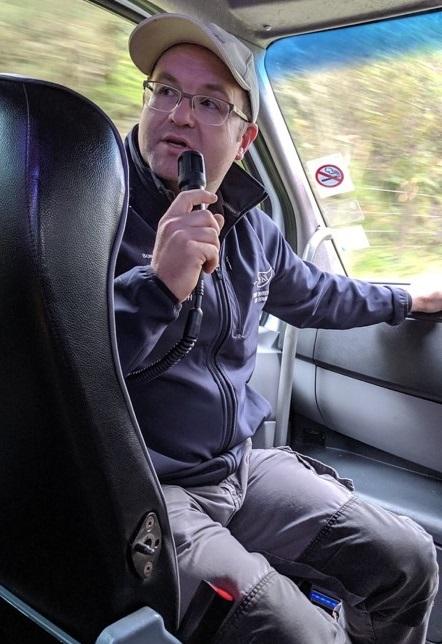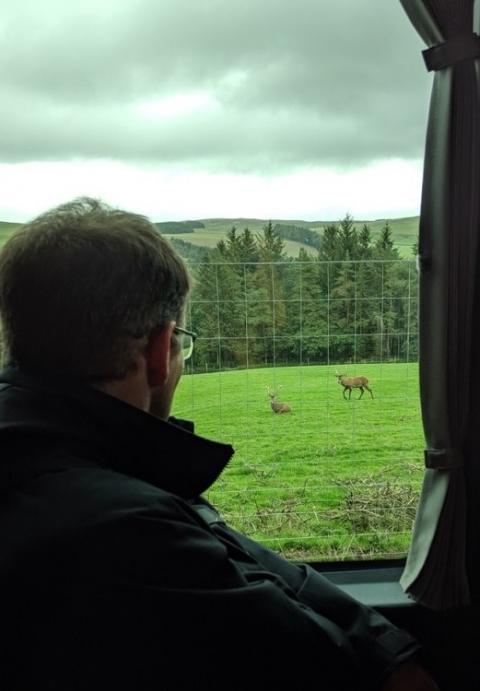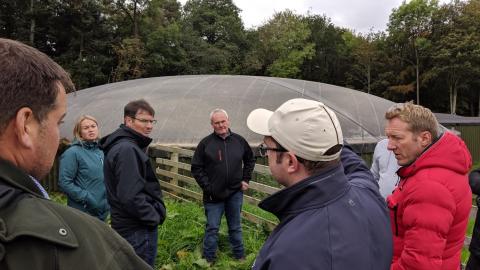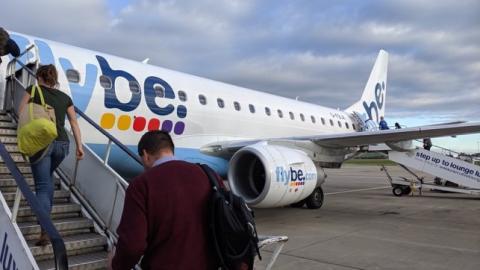Farming Connect Study Visit - Brecon Grassland Society
Funded by Farming Connect through the Knowledge Transfer, Innovation and Advisory Service programme under the Welsh Government Rural Communities – Rural Development Programme 2014 – 2020
Brecon Grassland Society
Scotland
27 - 30 September 2019
1 Background
Brecon Grassland Society consists of 50 dynamic members from across Brecknock, with a passion to learn more about effective grassland and stock management in order to build resilience within their businesses.
The Society is spearheaded by Chairman, Huw Jones from Wholehouse Farm. Huw has a passion for continued learning and wanted his legacy as Chairman to revolve around knowledge sharing, embracing change and inspiring members to evolve their businesses to build prosperity.
The study visit to Scotland had been one of the highlights of the Brecon Grassland Programme to date. It provided an opportunity for the group of twenty members to visit progressive farms in Scotland, learn from them and provide the perfect opportunity to discuss innovation and effective management with some of Scotland’s most prolific farmers.
The Scottish Borders were chosen for the visit due to the many comparatives they share with the Brecon Beacons, including the rainfall, rural setting and landscape.
While aiming to embrace every visit on the tour, the enthusiastic members of the newly formed group were also eager to share their experiences and bounce ideas off each other.
Members were keen to take comparisons of good practice and spot originality on the farms which, in turn, could improve efficiencies in their own enterprises back in Wales.
The Society is active in encouraging younger members and women alike, along with having several sectors within the agricultural industry also covered.
The opportunity to visit farms in a different country, learn about how Brexit is impacting Scottish Agriculture, and see how they are making the best of the resources would be beneficial to all.
The diversity of the group, along with having the opportunity to see first-hand how farmers in Scotland are striving to be as efficient as possible, harnessing innovative farming techniques, renewables and utilising all that their farms have to offer with regard to diversification projects, was a key objective and motivating to all.
Another key objective many were keen to achieve was to learn how holding the Official Tuberculosis Free Status has benefited Scottish cattle farmers. A keen interest in experiencing farms embracing grass-based systems was also a favourable outcome from the study visit.
It was also hoped that members would return enthused and keen to access more Farming Connect services to improve their own farms. 35% of the members who attended the trip were female and the ages ranged from 18 to 70.
The study visit comprised of members from the sheep, beef, and dairy industries along with agricultural contractors, a nurse, two civil servants, a business consultant and a student.
The diversity of the group allowed for more varied discussions and viewpoints for consideration.
2 Itinerary
Day 1
Friday 27 September 2019
The group of twenty met in Brecon late afternoon and shared a bus to Cardiff International Airport to catch an evening flight to Edinburgh.
After a calm flight and swift transfer, the group travelled to its base for the study visit - The Peebles Hydro Hotel in the Scottish Borders. The site was chosen due to its central location and proximity to the four farms (max one-hour travel to the first farm each day) allowing more on-farm time to absorb the information and experience.
Day 2
Saturday 28 September 2019
Eager to learn from some of the most prolific farmers in Scotland, the group was picked up from the hotel at 8.30am and travelled to the first farm.
Glenrath Estate Ltd – Sir John Campbell and Nikki Campbell
The Brecon Grassland Society was warmly welcomed to the Glenrath Estate headquarters by the company’s charismatic hosts.
Sir John Campbell, alongside his ninth granddaughter Nikki, captivated the group and threw themselves into telling the group about the journey of the company’s humble beginnings and subsequently becoming Scotland’s largest egg producer.
The enthusiasm and knowledge of the egg industry, particularly by Nikki, was incredible alongside the wit of Sir John, and they engaged with the members and lively discussions ensued.
Glenrath Farms is a family owned business that was established by John and Cathy Campbell in 1959. Sir John, a butcher’s son with an incredible amount of drive, whom became a first-generation farmer after buying some ground near Peebles with his wife, amassed a tremendous amount of ground over the years and established a thriving business.
It was 50 years ago that Cathy Campbell started selling eggs door-to-door, supplementing the income of the family farm. It was so successful that her husband John, got involved and they became a supplier to Spar. A contract with Tesco followed shortly, and the business has expanded ever since.
As a company, the Campbells aren’t afraid of challenges. “In business, if you’re not moving forward, you’re going backwards,” Sir John Campbell stated.
Glenrath has 1.6 million laying hens, most of which are kept within 20 miles of head office. Rearing has been part of the enterprise from the start, with additional pullet requirements bought in. The family own and farm a total of 15,000 acres and employ 230 staff.
Glenrath Farms is the largest supplier of free-range eggs in the UK, which makes up 45% of production and continues to expand with demand. It is also one of the top 10 poultry companies in the UK, with an annual turnover of £56m, selling around 10 million eggs a week.
There are now three generations of the Campbell family working throughout this multi-million-pound business. However, as farmers, they haven’t lost their roots, keeping 10,000 breeding ewes, plus 500 Limousin and Charolais suckler cows. These are sold for both meat and as breeding stock.
Sir John was passionate about embracing change and working alongside the supermarkets. He insisted, “why fight the supermarkets when the consumers know best?”
The business has invested in a £6m egg processing and pasteurisation plant at its heart, alongside Glenrath now ripping out all of the caged hen facilities across their 45 chicken sheds and converting them back to barns, in line with consumer demand.
Innovation and flexibility are clearly important; however, product quality underpins the company’s business ethos. All eggs are produced to the BEIC Lion Assurance Standard.
Management and nutrition strategies are employed to limit egg size. They aim for an average egg weight of 64g at the end of lay. This is particularly important for the mixed weight packs, where there is a minimum weight of 805g for the 15 eggs. “If eggs are bigger, we are giving away extra weight for free, which doesn’t make business sense.”
Quality at the end of lay is also important, so calcium levels are increased to improve shell strength. There are other economic considerations too. If eggs break in the packing station, other eggs become unsalable and packaging can also be ruined. The line may have to be stopped and cleaned, costing the business time and money.
This is where the new grading machine plays a role, removing eggs with hairline cracks and preventing breakages further down the line. Glenrath also uses robots to put eggs into the packs, further reducing wastage.
Preventing damage to eggs before they get to the packing station is also a priority. They have reduced cracks by 4% by updating conveyor belts in the houses, and other changes in the free-range units. When they are grading up to two million eggs a day, this makes a big difference to productivity.
Packaging also plays an important role in delivering quality eggs to customers. To this end, Glenrath has recently introduced plastic packs to several of their ranges. These are made of recycled plastic bottles, which use less energy in their production compared with cardboard packs.
Recycled packaging isn’t the company’s only green initiative. Last year the Campbells planted 20,000 trees to help maintain Scotland’s woodland as well as creating a better environment for their free-range hens.
Cathy Campbell diversified the business further by expanding their property portfolio to over 90 properties across the farms.
The group was overwhelmed by the vast size of the enterprise, the amount of ground owned by the family and the charisma of its founder. The enterprises work well together, however, the group felt that the business needed to harness natural energy and renewables going forward, to aid their environmental responsibility and potentially squeeze production costs further.
Sir John and Cathy’s legacy was greatly admired and it was an incredible first farm to start the tour.
Key points learnt from Glenrath
- The scale of development and the vision for the future.
- Plan, focus and take calculated risks to embrace every opportunity. Say ‘yes’ to everything and worry about logistics after.
- Knowledge is key. The most valuable thing a business can spend money on is expert advice.
- Positivity
- Work closely with the supermarkets and adapt to change before it is forced upon a business.
- Attention to every detail across all the enterprises.
- Know what your consumer wants ahead of the curve.
- Use technology to increase efficiencies, productivity and reduce waste.
- The strength of a charismatic founder drives the business forward.
- Be creative to motivate staff and bring the best qualities out in them.
Bank House Farm – Graham Lofthouse and Wilma Lofthouse
Bank House Farm at Stow was the most comparable in size to the group’s farms in Wales, and the group found it inspirational to see how productive it was in terms of both grass production and kilos of meat produced per hectare of grass.
It was clear to see how this 107-hectare farm lifted the title of AgriScot Scottish Sheep Farm of the Year in 2016. Graham Lofthouse’s knowledge and attention to detail, along with the impressive results delivered by continuous small improvements, encouraged the group to make small changes to their businesses.
The family has managed to reduce input costs and subsequently cut down bought-in feed by 60% while increasing production. The farm had a setback when it lost 14 hectares out of its total 121 ha through compulsory purchase for the Waverley Rail project five years ago.
Graham said: “Losing the ground to the railway has certainly caused us some issues. We have a long, narrow farm, so the railway now covers 4.1 miles of our land, which we used to winter 300 ewes and 30 cows on. We have re-invested the compensation money into building housing for stock through the winter.”
Graham has been operating a closed Easycare flock for eight years, using home-bred tups for the majority and buying in Suffolk tups for about 100 ewes in what he calls the “B” flock.
“Any ewe who has problems is ear notched and given a chance in the “B” flock, but her lambs are never retained,” said Graham. “If she has problems a second year, she will be culled. Using Suffolk rams lets me easily identify lambs which should not be retained, and the fast growth rates allow me to finish them early.”
This autumn, Graham ran 106 out of 123 ewe lambs with the tup. His criterion for ewe lambs to go to the tup was that they must have reached 65% of their mature weight, or 40kg, at tupping time. The hoggs scanned 110%, with the ewes at 184%.
Through careful management, lamb losses are kept to a minimum. In the last seven years, they have had an average lamb mortality rate of 7% from scanning to sale. Body condition and nutrition are the key focus points for keeping cost of production down, and the biggest opportunity for this is grass. Graham expressed that grass is the perfect high-quality feed, with the right balance of protein and energy and they need to exploit its potential.
Sheep and cattle have been on a rotational paddock-grazing system at Bank House for several years, and grass production has improved from 7,600kg DM/ha to 10,800kg DM/ha. Graham is now making 500 tonnes more silage than previously, all at around 11ME, and he has reduced bought-in feed costs by 60%.
Graham has been recording stock and grassland data for over ten years and has a bank of factual knowledge stored to help him analyse his stock performance alongside being able to calculate winter feed budgets and forecast any potential shortfalls in grass growth in order to make better informed decisions and comparisons to previous years.
Grazing management was a key topic of the study visit and Graham’s system was fascinating to many members of the group. His attention to detail, knowledge, and his ability to modify everyday items to get around the farm more efficiently was enviable.
Making a net profit without Single Farm Payment is a business objective for Graham, and he has achieved this consistently in the last four years. He is an advocate for benchmarking his costs of production and monitoring his financial performance which, in turn, helps him make informed management decisions.
Graham is a key member within grazing groups in Scotland and attributes the ability to bounce ideas with forward thinking farmers as fundamental to his business.
The lambs not retained for replacements are all finished and sold to Scotbeef at an average 18.7kg deadweight, R2 or R3L grade or above. With only 130 lambs left to sell at the end of November, only two “O” grades had been recorded.
Graham works closely with his vet practice to maintain a comprehensive flock health plan which includes faecal egg counts, a fluke plan and regular body condition scoring.
For the last four years, Bank House ewes have consistently managed to produce more than their own body weight in lambs at weaning. Graham has recently installed an electronic weigh crate, which allows him to weigh and assess ewes individually rather than on a flock basis. He can now select his ideal breeding females, which are smaller sheep with high growth rates and excellent maternal traits.
The cattle enterprise of 72, mainly Simmental cross suckler cows, complements the sheep side of the business, and Graham’s focus is now on using Aberdeen Angus and Hereford bulls to bring down cow size and manage the cattle as efficiently as the sheep on the farm.
Key points learnt from Bank House
- Positivity
- Continuous small changes in the right direction can have huge impacts
- Attention to detail
- Share knowledge and always be open to learning new skills. Discussion groups are a great platform to utilise in farming
- Data recording is key with both stock and grassland
- Plan ahead for winter grazing strategies and foresee shortfalls in feed availability by using technology and computer programmes
- Know your cost of production
- Paddock grazing, although a lot of infrastructure is required, is key to gaining better grazing management and increasing productivity
- The strength of a focused founder drives the business forward
- Be creative when modifying equipment to improve efficiency
Saturday evening
A short walk into the local town of Peebles saw the group go for a meal together, which provided a relaxed environment to evaluate the day’s farm visits and bounce ideas of best practice off each other.
Day 3
Sunday 30 September 2019
With another action-packed day planned, the group promptly got picked up at 8.45am and listened to the Welsh match on the radio while heading to the first farm of the day.
Upper Nisbet Farm – Robert Neill and family
The Neill family took on the tenancy of Upper Nisbet in 2000. The farm is 791 hectares and forms part of the Lothian Estate.
The farm currently stock 320 suckler cows on 438ha. This number has increased gradually year-on-year since the Neills arrived at Upper Nisbet with 200 cows in 2000. The majority of the cows are Limousin cross British Friesian, but some British Blue breeding has been introduced into the herd, and the recent purchase of an Aberdeen Angus bull will be used to breed replacement heifers.
The main supply of replacement heifers is sourced from the family dairy farm. The replacement Friesian heifers are put to the Limousin bull to produce the first crosses for the suckler herd. There is a small herd of pedigree Limousin cows which are used to breed bulls to be used on the suckler herd. All progeny from the suckler herd are finished on home-grown fodder and sold live throughout the year, mostly to local butchers.
The arable production area of the farm has doubled since taking on the tenancy, and there is now 353.38 hectares of land.
In 2017, the arable crops being grown equated to 73.88 hectares of winter barley which is mostly dried and kept in long-term storage to be fed to the beef herd, with the remainder being sold under a seed contract. 99.11 hectares of winter wheat is grown mostly on a seed contract, with a small quantity being kept for feed. 163.56 hectares of spring barley is split between malting barley contracts and seed contracts. 16.83 hectares of land is being rented out to a neighbouring farmer for growing potatoes.
All of the straw from the cereal crops is baled and retained on the farm for feeding and bedding, which is then spread on the arable ground as farmyard manure to enhance the soil quality and texture. Three days prior to our visit, the farm experienced an arson attack which saw one of their sheds burn down containing 900 bales of straw.
Robert is a hugely inspirational and forward-thinking individual and won the Mixed Farmer of the Year award and then went on to win the Farmers Weekly overall award for The Farmer of the Year 2017. His drive and attention to detail, alongside his desire to strive for better efficiencies and openness to invite people onto his farm to learn more about his system, was compelling.
Harnessing technology, Upper Nisbet has been using electronic identification in their Suckler Beef herd for a number of years. “As well as simplifying the regular weighing of our prime stock, we have also developed a system of printing bar code labels for each animal entering the cattle crush. This system can be used when blood sampling to avoid human error and also to increase throughput of animals.
“The beef and arable enterprises complement each other and each provides a benefit to the other sector. The suckler herd are providing a plentiful supply of farmyard manure to improve the nutrient value of the soil, and the arable crops provide not only feeding, but also bedding in order to reduce our input costs,” Robert explained.
Robert has travelled extensively and credits his Nuffield Scholarship for giving him focus and allowing him to see innovations which could be implemented on his farm to increase productivity.
The ability for all team members to be able to turn their hand to any job on the farm increases output and allows for the farm to progress on such a scale year-on-year. Robert sets the team a large project each year to achieve on-farm, to improve facilities alongside carrying out the day-to-day farming jobs to a high standard.
The farm was immaculate and the family’s passion for the industry is clear for us all to see. The ability to want to share knowledge is evident in the amount of study groups the farm is involved with, and the openness to the public and specifically younger generations to educate about agriculture, was inspiring and a credit to the whole family.
Key points learnt from Upper Nisbet:
- A good relationship with the landlord has allowed the size of the tenancy to increase, justifying capital expenditure and ensuring that both sons are able to farm if they so wish.
- The farm invested in a weighbridge and a combine with yield mapping capabilities after expanding the arable area to precisely monitor field yields.
- The farm installed automatic weighing stations at drinkers in cattle sheds to reduce handling stress and monitor daily live weight gain more effectively.
- An electronic weigh head in the cattle handling system is used to ensure that correct dose rates of medication are delivered to maximise efficacy and avoid wastage.
- Positivity.
- The attention to detail was phenomenal and the tidiness of the farm was very desirable.
- The use of electronic cattle EID tags and DNA testing for all cattle from birth means that it is possible to monitor cattle performance over a longer term and to be able to analyse high performing bloodlines.
- Goal setting and the ability to remain focused increased productivity.
- Creativity and innovativeness in modifying equipment, gates, machinery to allow increased efficiencies and ability to carry out many tasks safely and less reliant on extra staff.
Bowhill Estate – Sion Williams
Sion Williams, farms manager at the Bowhill Estate, is responsible for 13,500 acres under Bowhill Farming Ltd and 20,000 acres under Eskdale and Liddesdale Farming Ltd. Stocking includes 600 suckler cows (both pedigree and commercial), a flock of 10,800 ewes, 116 hinds for venison, a 32,000-hen poultry unit and a 200kW Anaerobic Digestion Plant.
The estate grows 40 hectares of spring barley and 8 hectares of spring oats for stock feed and 36 hectares of kale for fattening lambs and feeding suckler cows; the remainder of the land is down to grass or heather moorland.
Bowhill is an incredibly diverse business with several enterprises all working alongside each other and effectively managed and driven forward by Sion. His ability to run such a large, diverse business and maintain high standards, good staff retention and grow the business year-on-year is phenomenal.
Pedigree cows at Bowhill include 150 premium-health pure Aberdeen Angus cows, from which they produce replacements for the remainder of the herd. The herd also produces pedigree Aberdeen Angus breeding stock for selling to pedigree and commercial farmers. All of the cows calve in the spring during a nine-week period.
Around 50 premium-health commercial cows, of which they breed further replacements for the herds and produce beef calves for beef production. The breeds involve a Beef Shorthorn crossed to the Angus for production of breeding and sale replacements, all of which calve around the 13 March for a period of nine weeks.
A further 200 suckler cows held on the hill farm are predominantly Shorthorn X, where the Charolais is used as a sire for the bulk of the beef calves. All of the cows calve in the spring over a nine-week period.
For winter housing, the calves are weaned from their mothers and housed on straw/slats before being sold store. On an annual basis, there will be around 370 beef store calves fed through this system. Roughly 90 heifers will be maintained with about approximately 70 going into herds, and the balance will be sold as premium-health heifers between 12-18 months. The balance of the calves will be sold at turnout at about 12 months of age.
The sheep enterprise consists of a hill flock where they run 2,690 Scottish Blackfaced breeding ewes which are maintained on the 2,059 hectares of heather moorland at Bowhill. Breeding practice is to produce pure bred Blackies or crossing to a maternal New Zealand sire which increases growth and size and produces replacements for the in-bye flock. The remainder of these lambs are used for fat lamb production, from which they supply Marks and Spencer and Sainsbury’s.
The in-bye flock is currently at 1,300 heads of Pure Highlander, Primera, plus crossbreeds such as Highlander x, Lleyn x and Greyfaced ewes (all maternal crosses to the Scottish Blackface). These are mainly kept for fat lamb production; however, they do produce pure Highlander and Primera breeding stock for selling sires or for keeping as replacements.
Financially, both the hill and lowland flocks at Bowhill perform strongly, generally sitting in the top third of Scottish flocks in QMS’ costings.
The team also receives a lambing bonus based on the flock’s overall financial success. If the flock performance is between the average and top third of flocks in the QMS costings, the team receives a bonus of 75p/lamb. However, if it is in the top third, the bonus increases to £1.50 a lamb.
Bowhill operates a 32,000-hen free-range egg laying unit on the farm. This was a diversification project for the farming business as it does not rely on agricultural subsidies. The unit was erected in 2005 and has been an asset to the business as it supplies chicken muck manure to the arable, anaerobic digester and grassland enterprises on the farm. This helps reduce costs and benefits the environment by using fewer non-organic fertilisers.
A relatively new enterprise at Bowhill is the addition of 116 deer. The infrastructure is currently being put in place, and Sion envisages the herd to grow and allow the enterprise to flourish and complement the other sectors within the estate.
Efficiency improvements and market-focused changes to sheep, cattle and arable enterprises have been central to his policies.
Sion achieves this by extensively benchmarking all enterprises in order to maximise output while minimising costs. EID records weights, movements and veterinary treatments of all cattle and sheep. He is currently a LEAF Demonstration Farm and one of 32 Agri-Epicentre Satellite farms (alongside Robert Neill), embracing technologies such as satellite imagery looking as pasture levels, cattle boluses looking at cow temperatures and agility, and water drinking weighers.
Key points learnt from Bowhill
- Impressive vision and commitment shown by Sion
- Positivity
- Attention to detail and outstanding management skills
- Share knowledge and always be open to learning new skills. Discussion groups are a great platform to share best practice and invaluable for networking.
- Data recording is key across every aspect of the business
- Delegate jobs and harness the strengths of others around you
- Know your cost of production and make sure all enterprises are costed out and performing well, not just one.
- The ability to utilise renewable energy and tie it in with the brand
- The strength of a focused leader drives the business forward
- Be creative to get the best out of your team.
Sunday evening
The group enjoyed a meal together and openly discussed all the farms visited and shared the highlights from each enterprise with one another. It provided a fantastic opportunity to share different viewpoints and allowed members to relate to their own businesses back in Wales.
Day 4
Monday 30 September 2019
The group of twenty headed back to Edinburgh to catch a flight to Cardiff Airport and reflected on the study visit.
3 Next Steps
Members returned from the study visit motivated and keen to implement some of the things they have learnt in Scotland on their own farms in Wales.
The trip has given members a sense of unity and highlighted the benefit of having a discussion group as a platform for embracing change, driving focus and sharing best practice. The group gelled effectively and visiting Scotland allowed members to network outside their comfort zone.
Each of the farmers whom the group visited expressed the importance of continuous learning and highlighted programmes such as Grazing Groups and Nuffield Scholarships as being invaluable to their development.
The farmers showed several compelling common traits; they all showed fantastic attention to detail, creativity, embraced technology to suit their farms, they had incredible focus when goal setting and passion. Passion is so important in any business, and it was great to be surrounded by, and network with, so many forward thinking, progressive farmers from Scotland and within our Society, whom are passionate about our industry and its future post Brexit.
The study visit has allowed members to contemplate potential changes that their businesses could undertake to build resilience.
These include:
- Rotational grazing and grassland improvements
- Animal health enhancements
- Diversification
- Renewable energy
- Share farming
- Succession
- Business planning in light of Brexit
Many of the members are keen to access and use further Farming Connect services, including mentoring, training courses and soil sampling, alongside applying for programmes such as the Agri Academy and Prosper from Pasture, to further expand their knowledge and skill set.
The Brecon Grassland Society is also keen to harness the potential of Farming Connect in securing funding for keynote speakers to attend future Society meetings.
The study visit to Scotland provided an invaluable experience for all members whom participated, and the effects of the tour will be evident for many years.
The Society are extremely grateful for the generous time all four farmers and their families gave the group, alongside Farming Connect for helping with contacts and funding.


